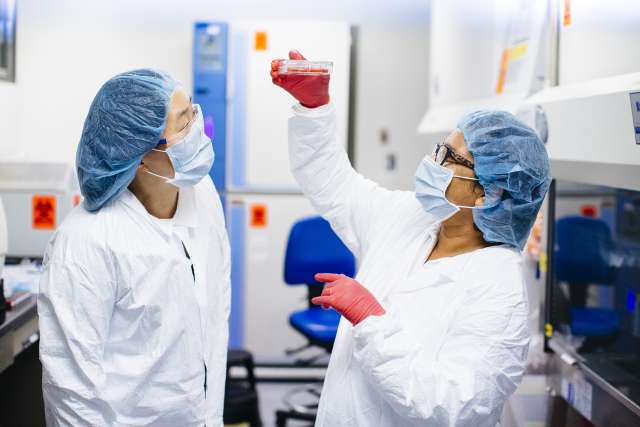As the COVID-19 pandemic rages on, UCLA researchers are rising to the occasion by channeling their specialized expertise to seek new and creative ways to reduce the spread of the virus and save lives. Using years’ — or even decades’ — worth of knowledge they’ve acquired studying other diseases and biological processes, many of them have shifted their focus to the novel coronavirus, and they’re collaborating across disciplines as they work toward new diagnostic tests, treatments and vaccines.
At UCLA, more than 230 research projects, including several being led by members of the Eli and Edythe Broad Center of Regenerative Medicine and Stem Cell Research at UCLA, are contributing to that mission.
“As a result of the pandemic, everyone on campus is committed to finding ways that their unique expertise can help out,” said Dr. Brigitte Gomperts, professor and vice chair of research in pediatric hematology-oncology and pulmonary medicine at the David Geffen School of Medicine at UCLA and a member of the UCLA Children’s Discovery and Innovation Institute. “So many of my colleagues have repurposed their labs to work on the virus. It’s very seldom that you have one thing that everybody’s working on, and it has been truly inspiring to see how everyone has come together to try and solve this.”
Here’s a look at five projects in which UCLA scientists are using stem cells — which can self-replicate and give rise to all cell types — to take on COVID-19.
Using lung organoids as models to test possible treatments
Dr. Brigitte Gomperts
UCLA Broad Stem Cell Research CenterDr. Brigitte GompertsGomperts has spent years perfecting methods for creating stem cell–derived three-dimensional lung organoids. Now, she’s using those organoids to study how SARS-CoV-2, the virus that causes COVID-19, affects lung tissue and to rapidly screen thousands of prospective treatments. Because the organoids are grown from human cells and reflect the cell types and architecture of the lungs, they can offer unprecedented insights into how the virus infects and damages the organ.
Gomperts is collaborating with UCLA colleagues Vaithilingaraja Arumugaswami, a virologist, and Robert Damoiseaux, an expert in molecular screening. Their goal is to find an existing therapy that could be used to reduce the spread of infection and associated damage in the lungs.
“We’re starting with drugs that have already been tested in humans because our goal is to find a therapy that can treat patients with COVID-19 as soon as possible,” Gomperts said. Read more.
? ? ?
Repurposing a cancer therapy
Vaithilingaraja Arumugaswami, associate professor of molecular and medical pharmacology at the Geffen School of Medicine
UCLA Broad Stem Cell Research CenterVaithi ArumugaswamiIn addition to collaborating with Gomperts, Arumugaswami and Damoiseaux identified the cancer drug Berzosertib as a possible treatment for COVID-19 after screening 430 drug candidates. The drug, which is currently being tested in clinical trials for cancer, works by blocking a DNA repair process that is exploited by solid cancers and the SARS-CoV-2 virus, and the UCLA scientists found that it is very effective at limiting viral replication and cell death.
“Clinical trials have shown that Berzosertib blocks the DNA repair pathway in cancer cells, but has no effects on normal, healthy cells,” Arumugaswami said.
Now, Arumugaswami and Gustavo Garcia Jr., a staff research associate, are testing Berzosertib and additional drug combinations on lung organoids developed in Gomperts’ lab and stem cell–derived heart cells infected with SARS-CoV-2. They suspect that if the drug is administered soon after diagnosis, it could limit the spread of infection and prevent complications. Read more.
? ? ?
Studying the immune response to the virus
Dr. Gay Crooks, professor of pathology and laboratory medicine and of pediatrics at the Geffen School of Medicine, and co-director of the Broad Stem Cell Research Center; and Dr. Christopher Seet, assistant professor of hematology-oncology at the Geffen School of Medicine
UCLA Broad Stem Cell Research CenterDr. Gay Crooks and Dr. Christopher SeetCrooks and Seet are using stem cells to model how immune cells recognize and fight the virus in a lab dish. To do that, they’re infecting blood-forming stem cells — which can give rise to all blood and immune cells — from healthy donors with parts of the SARS-CoV-2 virus and then coaxing the stem cells to produce immune cells called dendritic cells. Dendritic cells devour viral proteins, chop them up into pieces and then present those pieces to other immune cells called T cells to provoke a response.
By studying that process, Crooks and Seet hope to identify which parts of the virus provoke the strongest T-cell responses. Developing an effective vaccine for SARS-CoV-2 will require a deep understanding of how the immune system responds to the virus, and this work could be an important step in that direction, giving researchers and clinicians a way to gauge the effectiveness of possible vaccines.
“When we started developing this project some years ago, we had no idea it would be so useful for studying a viral infection — any viral infection,” Crooks said. “It was only because we already had these tools in place that we could spring into action so fast.” Read more.
? ? ?
Developing a booster that could help a vaccine last longer
UCLA Broad Stem Cell Research CenterSong LiSong Li, chair and professor of bioengineering at the UCLA Samueli School of Engineering
A COVID-19 vaccine will need to provide long-term protection from infection. But how long a vaccine protects from infection isn’t solely dependent on the vaccine.
The human body relies on long-living immune cells called T memory stem cells that guard against pathogens such as viruses and bacteria that the body has encountered before. Unfortunately, the body’s capacity to form T memory stem cells decreases with age. So no matter how well designed a vaccine is, older adults who don’t have enough of a response from T memory stem cells will not be protected long-term.
To address that issue, Li is developing an injectable biomaterial vaccine booster that will stimulate the formation of T memory stem cells. The booster is made up of engineered materials that release chemical messengers to stimulate the production of T memory stem cells. When combined with an eventual SARS-CoV-2 vaccine, they would prompt the body to produce immune cells primed to recognize and eliminate the virus over the long term.
“I consider it my responsibility as a scientist and an engineer to translate scientific findings into applications to help people and the community,” Li said. Read more.
? ? ?
Creating an off-the-shelf cell therapy
Lili Yang, associate professor of microbiology, immunology and molecular genetics in the UCLA College
UCLA Broad Stem Cell Research CenterLili YangInvariant natural killer T cells, or iNKT cells, are the special forces of the immune system. They’re extremely powerful and can immediately recognize and respond to many different intruders, from infections to cancer.
Yang is testing whether iNKT cells would make a particularly effective treatment for COVID-19 because they have the capacity to kill virally infected cells, offer protection from reinfection and rein in the excessive inflammation caused by a hyperactive immune response to the virus, which is thought to be a major cause of tissue damage and death in people with the disease.
One catch, though, is that iNKT cells are incredibly scarce: One drop of human blood contains around 10 million blood cells but only around 10 iNKT cells. That’s where Yang’s research comes in. Over the past several years, she has developed a method for generating large numbers of iNKT cells from blood-forming stem cells. While that work was aimed at creating a treatment for cancer, Yang’s lab has adapted its work over the past few months to test how effective stem cell–derived iNKT cells could be in fighting COVID-19. With her colleagues, she has been studying how the cells work in fighting the disease in models of SARS-CoV-2 infection that are grown from human kidney and lung cells.
“My lab has been developing an iNKT cell therapy for cancer for years,” Yang said. “This means a big part of the work is already done. We are repurposing a potential therapy that is very far along in development to treat COVID-19.” Read more.
Each of the projects is supported in part by the California Institute for Regenerative Medicine, the state’s stem cell agency.
“Our center is proud to join CIRM in supporting these researchers as they adapt projects that have spent years in development to meet the urgent need for therapies and vaccines for COVID-19,” said Dr. Owen Witte, founding director of the UCLA Broad Stem Cell Research Center. “This moment highlights the importance of funding scientific research so that we may have the foundational knowledge to meet new challenges as they arise.”
Crooks, Gomperts, Seet and Yang are all members of the UCLA Jonsson Comprehensive Cancer Center. Damoiseaux is a professor of molecular and medical pharmacology and director of the Molecular Shared Resource Center at the California NanoSystems Institute at UCLA.



